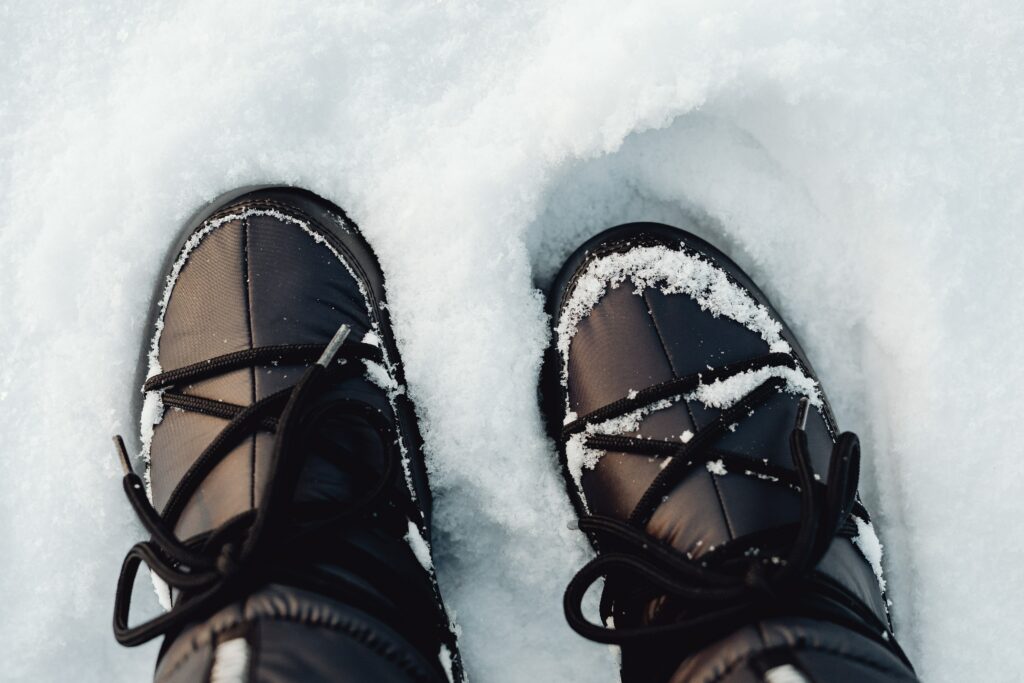
The snow is here and so is boot season. So, let’s talk about what to look for when buying boots for your children. My guess is that many (or most) of you already have boots for your baby, child, or teenager, but here are some tips if you are finding they just aren’t working.
The most important thing we look at is what we want the boots to do. Beside keeping our feet warm (Hello -30), we also want to ensure there is enough traction to prevent slipping on the ice and protect our feet. The material of the boot has a big impact on this. Especially when talking about traction, a rubber sole has much more grip than a vinyl sole. Another important thing is support! All of this will vary with age group, current function level, the anticipated function, muscle strength and the bony foot structure. We can also consider the weight of the boot, the ease in ability to put them on and take them off independently, and the need to accommodate an orthotic, brace or lift.
Before we get into boots for each age group, I want to address support. There are many widespread views of support. From our perspective, we want the body to be supported enough that all foot and ankle muscles are working efficiently and not overworking, and all core and glute muscles are working efficiently and not underworking. Both the core, foot and ankle muscles rely on the other to be successful. So, the position of the ankle DOES very much impact how strong you are above. This ankle position will vary between people, age groups, muscle strength and foot anatomy. Some may need more support, and some may need less.
Let’s talk about our little baby walkers. These little guys tend to be a little less active in the snow compared to the limit-pushing preschoolers. We don’t tend to see these little guys in deep snowbanks, but we may see them trying to run away from you on the ice. They also tend to be a little more unsteady. Because of this, we want to make sure they have enough traction to be successful on the flat icy areas. We also want them to be able to recruit their muscles effectively to stabilise themselves. What does this look like? In babies/toddlers that are quite balanced on their feet and who use their foot and ankle muscles well to stabilise themselves, we can continue to allow them to learn to use those foot intrinsics by putting them in a softer boot. The most common boot for this would be Stonz.
However, the biggest downfall of a soft bottom boot is protection. A natural shoe does not provide as much protection from stepping on a sharp rock, or “accidentally” kicking a tree. If this is your concern, especially if you know your baby/ toddler will be walking in nature or you have a very active baby/toddler, a hard bottom boot is going to be the better choice for you.
In hard bottom boots, there are so many varying levels of support. A lot of babies may not need a ton of support and may do well with shoes that accommodate their extra mobility. Boots, such as a Bogs B-MOC, Stonz Scout, Sorel Snow Commander, or Walmart George brand may work well for you. However, an extra strap around the ankle can provide a more ideal support to help hold that heel in place so their little muscles don’t work as hard. These boots exist in MANY different forms and price ranges. Recommended boots include: Kamik Snowcutie, Sorrel Whitney Strap, Olang Eolo, Walmart Thinsulate brand, Walmart Ice Fields Brand, Northface Alpen Glow, or Joe Fresh Quick Close.
But let’s talk about the babies that are not quite balanced on their feet, are learning to walk in winter months, are taking a bit longer to learn how to walk or the babies whose feet roll in more than is expected. This is where we want to look at straps and extra support. There is a wide variety of rigidness in boots that are available, and it can be hard to know which one to choose. In general, we want to look at how rigid the heel cup in the boot is. With the heel locked in place with a rigid heel cup and ankle strap, those ankle muscles do not have to work as hard to stabilise AND the core and glute muscles are in a better position to activate and assist in attaining balance. Examples include: Kamik Stance, Olang Cucciolo, Geox Flanfil, or Keen Knotch.

Lets’ talk about children ages 3-10 years old. This is the MOST active age-group in the snow. They run carefree on ice (cue the face grimace of moms everywhere), they jump in the highest snowbanks they can find, and they frequently need to take their snowsuit on and off to go pee. Because of this, the best boots for these guys are boots that are warm, have excellent traction, are light weight, are tall enough to block snow from getting in, and are very easy for them to get on and off independently. I will add one more thing. We want to make sure that those boots ALLOW them to do everything they want to do. What boots do this? There are a variety. Our recommended boots include Sorel Flurry, Kamik Waterbug, Keen Snowtroll, Walmart George brand, Stonz Trek, Joe Fresh Quick Close or Columbia Powder Bug. These boots provide the ankle strap, which helps to keep that heel in place to maximise function.
If your child has a tendency to roll their feet in, fall often or isn’t very balanced, the more rigid that heel or arch support is, the better. This includes Kamik Chinook, Sorrel whitney strap, Geox Sentiero, Kuoma Snowlock, Olang Bingo, or Walmart Thinsulate brand.
Now, for those pre-teen and teenagers who would rather dress for style rather than function (I was there, I get it). Let’s look at what they do in the winter. We tend to see less snow play, and more walking outside to get from one place to another. BUT they are outside long enough that our cold winter can make those toes turn into icicles. They also tend to wear their winter footwear all day long, due to no indoor footwear at school. So we need a shoe that can keep them warm, has good traction, and is comfortable and versatile enough to wear all day long. It may even go with the fashion choice of the day. Some boots that do this include Sorel puffy mid boot, Sorrel Whitney strap, Walmart Icefields brand, Columbia Minx Slip III, Northface Chilkat or Ugg Butte II.
So as a summary, the best boot for your child has many variables. The consistent factors across everyone is warmth, traction, protection and providing successful movement. I hope this helps you when you are looking for this year (or next) boots for your child.

